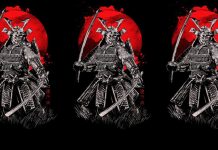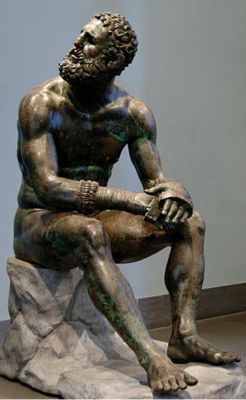 The human figure in motion offered extraordinary possibilities and inspiration to artists throughout centuries. By the human body performing certain martial arts movements, it has obtained a special place in sculpture and painting due to its grace and beauty, but also for the power of the movement it shows. It is assumed that the first visual mentions and, more generally, the interest for physical activity has appeared in different parts of the world approximately at the same point in history. However, it is important to note that the artistic value of a piece of art does not rely solely on the physical movement and the action of the depicted body, but also on the quality of the artist’s work. Balancing the visual and sports elements as well as the body’s movement is something that even the best artists found to be a great difficulty. Such problems with the design also depend on the artist’s personality, but have also changed due to various visual possibilities and “fashion“ through the centuries.
The human figure in motion offered extraordinary possibilities and inspiration to artists throughout centuries. By the human body performing certain martial arts movements, it has obtained a special place in sculpture and painting due to its grace and beauty, but also for the power of the movement it shows. It is assumed that the first visual mentions and, more generally, the interest for physical activity has appeared in different parts of the world approximately at the same point in history. However, it is important to note that the artistic value of a piece of art does not rely solely on the physical movement and the action of the depicted body, but also on the quality of the artist’s work. Balancing the visual and sports elements as well as the body’s movement is something that even the best artists found to be a great difficulty. Such problems with the design also depend on the artist’s personality, but have also changed due to various visual possibilities and “fashion“ through the centuries.
The oldest sports- visual topic was found in South Africa and has been dated to the mesosoic period (10000- 4000 B.C.). It is a wall painting that shows a group of hunters- runners. Works of art that show a similar movement have been found in Egypt, while others have been attributed to the Etruscan. The oldest painting, Pankration, comes even from the 16th century B.C. and was found in the village of Agia Triada and kept in The Heraklion Archaeological Museum (Crete). It is important to mention a fresco painting from the city of Knossos, Crete (1500 B.C.) that depicts an extraordinary scene of men leaping over a bull’s back. Further, the city of Tienen near Theba, Egypt is famous for a tomb’s wall painting which shows a group of Nubians carrying a board with a drawing of two wrestlers. It is speculated that the visual dates from the period of pharaoh Thutmose IV, around 1450 B.C. A fresco painting of young boxers on a wooden cover was made around the year 1500 B.C. (before the volcanic eruption) in Akrotiri on the Greek island of Santorini. The Sumerian have adopted the image of the hunter named Gilgamesh who is always shown naked killing a lion. Despite their cruel nature, the Assyrian people refused to depict their heroes naked so they have gradually dressed their visualizations of Gilgamesh and Heracles. Among their rich artistic production, the old Egyptians have left behind numerous sculptures, reliefs, paintings and drawings dedicated to martial arts. There have been found images of lancers and wrestlers in Saqqara, as well as those in Cairo and Ben Hassana. Divided into 120 groups, colored in black and red, they face a dynamic sequence.

The biggest number of art works that show the topic of martial arts were made in Ancient Greece and Rome, especially after the foundation of the Olympic Games in 777 B.C. They are mostly marble reliefs of wrestlers in a palaestra dated around the year 550 B.C. One of them shows a javelin thrower on a terracotta goblet which is today situated in a museum in Berlin and is dated 430 B.C. Further on, Polykleitos’ statue of Doryphoros (440 B.C.) is the model of the classic ideal of human beauty. According to the Greek canon, the head- body ratio equals 1:7. A good example of a relief design showing the image of wrestlers from Ancient Greece is kept in the National Archaeological Museum of Athens. Another famous sculpture is that of the wrestler Timanthes which is a part of the sanctuary in Olympia. There are various images of Heracles (called Hercules by the Romans). A marble statue of his figure with a club and lion’s skin is kept in London. Several old Greek vases painted by the artist Exsekias also show him fighting the centaur Nessus and the Nemean lion. Today they can be seen in Athens, while those painted by Euphronios are present in Munich.
Naples is the home of a famous relief that contains images of 153 gladiators. A unique visualization of terracotta soldiers was found in the tomb of emperor Qin Shi Huang Di (2nd century B.C.). Their bodies were carved in a rock in the north of China (in Xi’an –Shaanxi). Similar, but colored ceramic statues of warriors and guards were dated 6th century A.D. in the period of the Tang dynasty. Comparable statues were found even in India (3rd century A.D.).
The depictions of Heracles and Hermes are often seen in modern art. A statue of a slender fist fighter found in Rome in 1937 was attributed to Polykleitos’ artistic circle, while the statues of two famous wrestles found in Florence are a creation of late Greek artistry. On the other hand, the works of Agasius and Apollonius show a later design pattern and can today be seen in Rome, as well as the bronze statue of a professional fist fighter (1st century B.C.). The Etruscans left us numerous evidence of their affinity for movement and martial arts. The town of Tarquinius is home to a series of such artifacts. These pieces are completed with drawings on vases, wall frescoes and scenes of wrestling and spear throwing. Another gravure that was discovered shows a young fist fighter practicing punching on a bag of sand. The sketch also contains the author’s name, Novius Plautius. Ancient Roman art is flooded with such works of art and imagery represented in all sorts of techniques and decorative work which frequently also depict gladiator fights.
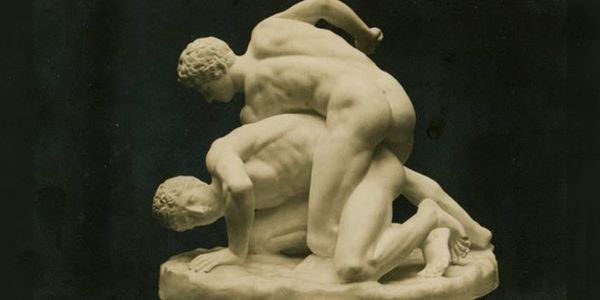
Art works are also excellent pieces of evidence which follow the development of sports equipment and their variety. Those that can today be found in Pompeii and Naples show how gladiators used a shield and a sword while their opponent held a trident and a net. Wild beasts such as lions, tigers etc. were also a part of the fight according to a relief in the Theatre of Marcellus in Rome. The surviving gladiator’s fighting equipment bears the evidence that his popularity was immense due to its luxurious features (for example, a decorated helmet).
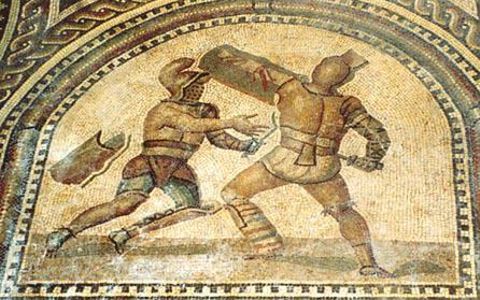
A mosaic from 1st century A.D. shows wrestlers from Aquincum, Budapest and today decorates the entrance floor of the town’s baths. Due to the spall of the Roman Empire and the consolidation of Christianity that happened in the Migration Period, the spiritual climate of the time was facing great changes. This period marks a certain shift from physicality which, in a visual sense, leads to bodily deformations and a hint of abstraction.
Situated on the other side of the world, the island of Java was at the beginning of the 9th century a place where, beside Hindi art, a variety of realistic decorations was made in the Buddhist temple of Borobudur. They contained images of athletes and archers.
The process of social development led to a small and carefully selected group of rulers and leaders in the Middle Ages. They as well as other knights took part in knights’ tournaments. Less often they would fight in matches without the help of horses, using a sword or a battle axe. These tournaments developed into luxurious ceremonies, full of colors, shinny armour, decorations placed on shields, clothes and equipment used by knights and horses. Artists tried to capture these visuals in many different ways including graphic techniques and paintings. Today, well known images are those of tournaments in St Gimignano (kept in Trento), Malpaga and Innsbruck as well as Henry VII’s tournament (kept in London).
The period of Humanism and Renaissance brought deep changes in the way of life, customs, fashion and freedom of thought which also had an effect on martial arts. The power of Michelangelo’s work and influence is shown in the fragment of the fight between Hercules and Cacus which can today be seen in Florence. Another example is the drawing of an archer kept in Windsor Castle. The great artist Leonardo da Vinci also made drawings of a crossbow and a horseman. He is also famous for organizing knights’ tournaments and for inventing a number of weapons.
The small bronze statues made by the artist Antonio dell Pollaiolo, Hercules and Antaeus, is a dynamic structure showing a wrestling match as well as a death outcome. The same image made in chalcography by a hand from Mantegna’s school is today kept in Munich. Various other visuals from this period showing wrestles and archers exist in Rome and Chantilly and are attributed to artists such as Lucas Cranach and Perugio.
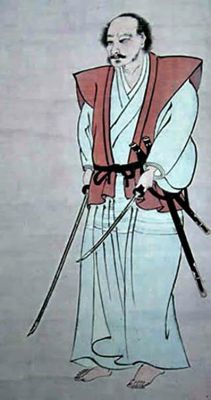 In the period of Manirism, more precisely in 1577, was written and published a book by the doctor Girolamo Mercuriale, De arte gimnastica, containing graphic images of fist fighting. One of the most important painters of the Baroque period, Peter Paul Rubens, depicted scenes of wolf, lion and leopard hunting. The Flemish artist Davied Teniers painted and archer with a bow and villagers with bows and arrows (the images are today in Rome and Vienna, respectfully).
In the period of Manirism, more precisely in 1577, was written and published a book by the doctor Girolamo Mercuriale, De arte gimnastica, containing graphic images of fist fighting. One of the most important painters of the Baroque period, Peter Paul Rubens, depicted scenes of wolf, lion and leopard hunting. The Flemish artist Davied Teniers painted and archer with a bow and villagers with bows and arrows (the images are today in Rome and Vienna, respectfully).
Topics of martial arts were present in the period of Rococo in almost every technique. The Bertarelli collection in Milan contains numerous graphic representations of fencing halls and fencing tournaments. On the other hand, martial movement as a topic was also present in Asian art. In the 18th century, the Japanese Master Shunsho made a woodcut representing two wrestlers as well as the wrestler Matana Goro and Kozunosabro in Tovokuni (they can be seen in Berlin). The artist Miyamoto Mushashi is also famous for his drawings of fencers. The Spanish painter Francisco Goya made a lithography called Bullfight, while the sculptor Antonio Canova prefered to highlight the human anatomy by setting aside the sports side in his images. Examples of that are the bodies of fighters named Kreugas and Damoksen, in Vatican.
Even more art works that showed scenes with hunting and fighting with wild animals were made during Romanticism. Eugene Delacroix’s Tiger Hunt (Paris) or the drawing called Arab horseman attacked by a lion (Harvard) are great examples of this. Once the Wrestler made by Gustave Courbet came to light, it initiated a more contemporary view on sport. Honore Daumier, the father of the caricature, created various drawings of boxers, wrestlers etc. His works are today stored in Paris. The French sculptor Antonine Bourdele carved a strong statue of Heracles as an archer, while the Croatian sculptor Ivan Meštović had an unique talent of combining the power of form and the dynamics of movement. His work is today kept in The Grand Park, Chicago and shows the figures of Indians as Archers and Spearme.
Another breakthrough in form was the work of Alexander Archipenko with his Boxers. In Germany, the sculptor Edwin Scharff made a figure of a boxer, while Wrestlers by Karl Albiker were molded in concrete. These artworks can be seen in Basel. Another figure of a wrestler was made by Hugo Lederer and Hans Wimmer carved the figure of a javelin thrower. Willy Jaeckel’s wall painting Boxing also received recognition as well as Max Slevogt’s painting A pause in the ring. These scenes of various sports became very interesting not only in their varied visual representations, but also in the thoughts and criticism they evoked. The aforementioned painter Francisco Goya often returned to the theme of corrida and was its chronicler throughout his career. Another Spanish artist, Pablo Picasso, who was famous for his visual experiments, showed a wounded picador in his linocut Picador and torero. Luc Albert Moreau made a lithography of a boxer called Eight, nine, ten. The American painter George Wesley Bellows’ paintings include Two Boxers (Washington) and a record of a famous fight between Dempsey and Ferpo in 1924 (New York). A number of Olympic winners made their way in art, for example, Paul Landowski’s Boxers made in 1928 (France) and the work Knockout made in 1932 by Mahoney Young. In the same year, the artist Lee Blair received a prize for his watercolor painting Rodeo. An honorable mention goes to a group of authors Saacke, Bailey and Montenot who made an architectural project called Arena for bulls.
Famous old Maori sculptures made of wood are located in New Zealand. The sculpture Maori warrior made of bronze is located in the yard of the Hotel Hamilton, in New Zealand.
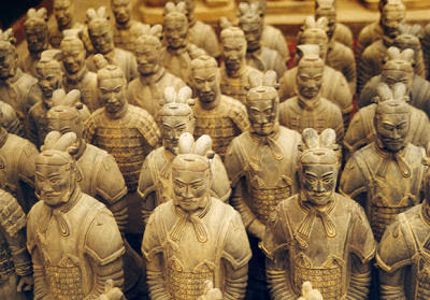
The Shaolin temple (named after the mountain Shao Lin) was built in 495, in the province of Henan (mid –China). It was looted several times, however, in 1928 it was destroyed nearly to its end. In 2010, the temple and the nearby pagodas (220 pagodas built between the 8th and 19th century) were included in the UNESCO’s list of world heritage as a historical monument of the province of Deng Feng. In the pavilion of 1000 Buddhas is also placed a famous fresco made by the painter Wu Da Ozi (the Tang family) in the 19th century. The famous tomb with terracotta warriors (tomb of first emperor Qin Shi Huang Di) was discovered in 1974 (in Xian). Visitors can only enter a restricted part of the tomb (open to visitors since 1987). Many Chinese works of art (pictures and documents) as well as monuments were destroyed in the period of the so- called cultural revolution that lasted from 1955 to 1978. The golden age of Chinese art is thought to be the period between the 10th until the 15th centruy, i.e. from the rule of the Song dynasty until the rule of the Ming dynasty. Also, the famous author Quing which lived in the 18th century painted various Chinese warriors.
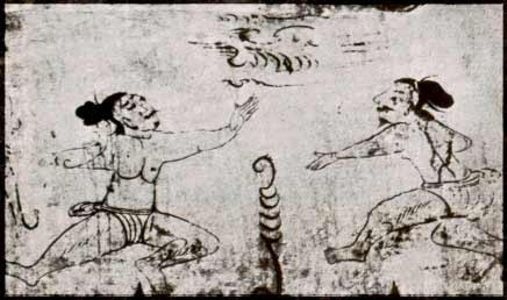
In 1935 in the town of Katchu Chong (Korea) were found various statues and paintings. They were located in the tomb Muyong Chong and were dated in the 3rd century B.C. (the Koguryo dynasty). On the ceiling of the Sam Sil tomb is a wall painting that shows warriors in different war poses from the period of the Three Kingdoms. The painting of the warrior Kumang Yoksa was also made in this period and can today be seen in the museum in Kyonggy.
Japan is famous for various armor and helmets from the Heian period (O-Yoroi is a full armour and Haramaki were protectors for the abdomen). Some of the most beautiful armor were made in the Edo period. Other famous helmets made in a half-moon shape come from this period and have different names- Zunari, Hoshi, Kabuto and Momonari. Japanese authors that lived in the 19th century were famous for there woodcuts, namely mastors called Utamaro and Hokusai. Many Japanese old swords – katanas are also well- known (Tokyo National Museum and Metropolitan Museum of Art-New York). They were crafted in different periods (between the 14th and 17th century) and include preserved engravings on their blades (Horimono). Famous statues of Miyamoto Musashi are located in places Mimasaka (Ganryu- Jima in Hikoshima) and in Kumamoto City. The famous Japanese comic books (Mangas) popularized martial arts. For example, Judo Icchokusen (Judo Dreams) were published between the years 1967 and 1971 and Karate Baka Ichidai were distributed in the period between 1971 and 1977.

Today, the famous sculpture of Bruce Lee is placed in Hong Kong and is the work of the artist Cao Chong-En. However, before this model, another statue of Bruce Lee was placed in Mostar (Bosnia) and is the work of the sculptor Ivan Fijolic.
Even today, many other artists produce various images, drawings and sculptures showing martial arts movements and sports.




